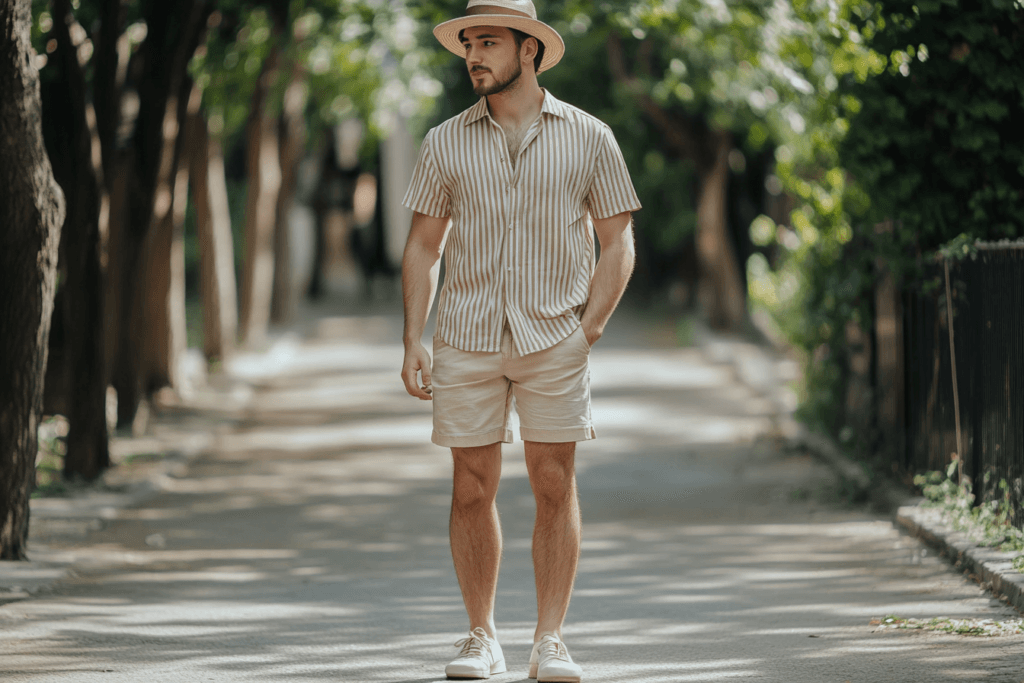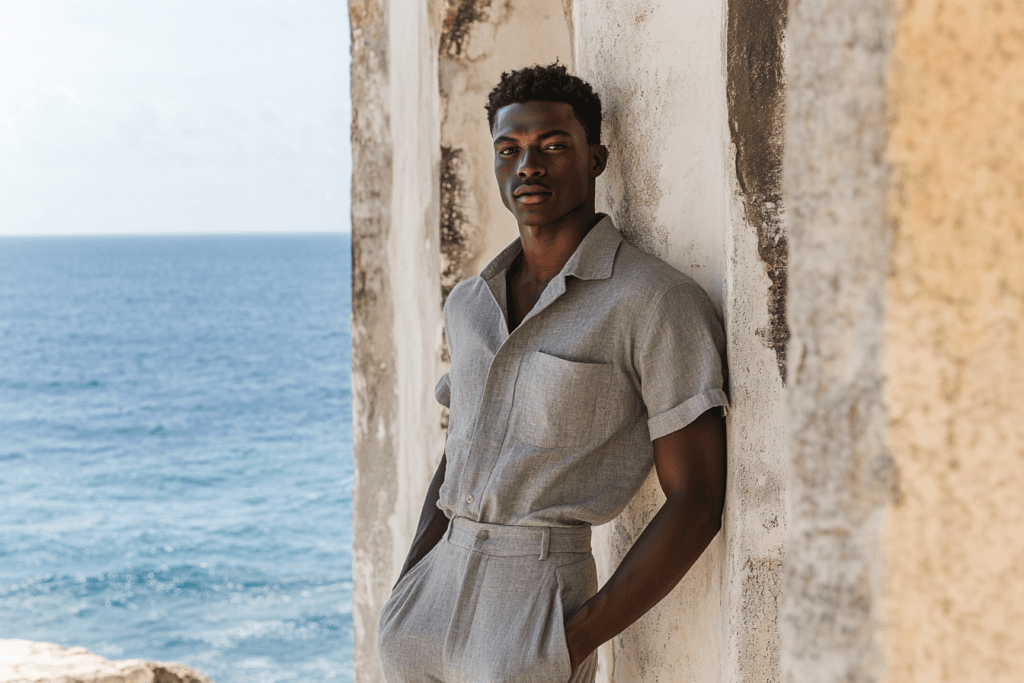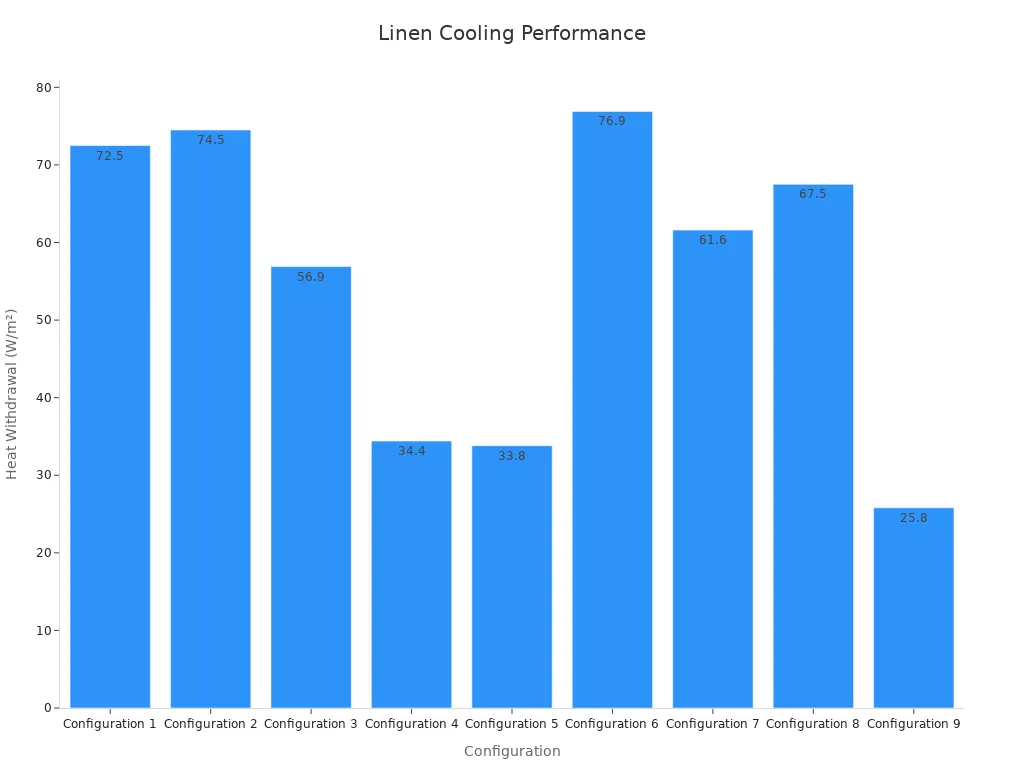
When it comes to breathable fabrics, bamboo fiber and linen are two standout options that dominate summer wardrobes for good reason. These natural textiles have been cooling human bodies for centuries (linen) and decades (bamboo), yet their modern applications in high-end shirting continue to evolve with innovative weaving techniques.
Bamboo fiber outperforms in humidity with its moisture-wicking capillaries that pull sweat away from skin like microscopic straws, while linen’s porous, irregular weave creates natural air channels perfect for arid heat. The former offers temperature-regulating smoothness ideal for tropical climates; the latter provides rustic breathability better suited to Mediterranean dryness.
But which fabric truly deserves prime real estate in your wardrobe? The answer depends on your personal ecosystem – whether you’re battling muggy subway commutes or sunbaked terraces. Let’s examine how these textiles behave where it matters most: against your skin during your daily adventures.
Key Takeaways
- Bamboo fabric works well in humid weather. It pulls sweat away fast, keeping you cool and dry.
- Linen is great for hot, dry places. Its open weave lets air move easily, giving natural airflow.
- Bamboo feels smooth and soft, perfect for delicate skin. It feels fancy and gentle on your body.
- Linen’s special feel gets better with every wash. It softens over time but stays strong.
- Pick bamboo for modern comfort and staying dry. Choose linen for lasting strength and being eco-friendly.
Which Breathes Better: Bamboo Fiber or Linen?
How Bamboo Fiber Enhances Airflow
If you’re looking for a fabric that keeps you cool and dry, bamboo fiber is a game-changer. Its unique structure allows it to absorb and release moisture faster than many other materials. In fact, bamboo fiber has about 60% greater water absorbency compared to cotton. This means it pulls sweat away from your skin and dries quickly, leaving you feeling fresh.
Bamboo lyocell, a type of bamboo fiber, takes things up a notch. Thanks to its nanofibril structure, it manages moisture 50% more effectively than cotton. This helps regulate your body temperature, so you won’t feel sticky or clammy, even on the hottest days. Whether you’re lounging at home or out in humid weather, bamboo fiber works hard to keep you comfortable.
What’s more, bamboo fiber’s breathability doesn’t just stop at moisture control. Its lightweight and soft texture allow air to flow freely, making it an excellent choice for anyone who wants a fabric that feels cool against the skin.
Linen’s Superior Natural Ventilation
Linen, on the other hand, is all about effortless airflow. Its loose weave creates tiny gaps in the fabric, letting air circulate freely. This natural ventilation makes linen perfect for dry, hot climates where staying cool is a priority.
You’ll notice that linen feels crisp and light, even when temperatures soar. It doesn’t cling to your skin, which helps you stay comfortable throughout the day. Plus, linen’s ability to wick away moisture adds to its cooling effect. While it doesn’t absorb as much water as bamboo fiber, it still does a great job of keeping you dry in arid conditions.
If you love a fabric that feels breezy and timeless, linen is a fantastic choice. Its natural texture and breathability make it a go-to for warm weather.

Which Feels Better Against Your Skin: Bamboo’s Softness or Linen’s Texture?
The Silky Softness of Bamboo Fiber
If you’ve ever touched bamboo fiber, you know how incredibly soft it feels. It’s often compared to silk, thanks to its smooth and luxurious texture. From the very first use, bamboo sheets feel silky against your skin, making them a favorite for anyone who loves a cozy, pampered experience.
What makes bamboo fiber so soft? The secret lies in its natural structure. Bamboo fibers are naturally smooth, which means they don’t irritate your skin. This makes bamboo an excellent choice if you have sensitive skin or allergies. You’ll feel like you’re sleeping on a cloud, without any roughness or discomfort.
Laboratory tests back up these claims. Using advanced sensory techniques, researchers have confirmed bamboo’s superior softness. One study even achieved a 98% accuracy rate in predicting the softness of fabrics containing bamboo fibers. That’s pretty impressive, right?
If you’re looking for a fabric that combines comfort with a touch of luxury, bamboo fiber is hard to beat. It’s soft, silky, and perfect for a restful night’s sleep.
Linen’s Distinctive Crisp Feel
Linen, on the other hand, offers a completely different kind of comfort. It’s not about silkiness—it’s about texture. Linen has a crisp, slightly rough feel that softens over time. With every wash, it becomes more comfortable, developing a lived-in charm that many people adore.
This textured feel gives linen its timeless appeal. It doesn’t cling to your skin, which is a big plus in hot weather. Instead, it feels light and breathable, almost like a gentle breeze on a summer day. If you love fabrics with character, linen is a fantastic choice.
While it may not feel as smooth as bamboo fiber, linen’s unique texture has its own charm. It’s perfect if you appreciate a fabric that feels natural and gets better with age.

Can Bamboo Outperform Linen at Sweat Absorption?
Bamboo Fiber’s Moisture-Wicking Properties
When it comes to staying dry and comfortable, bamboo fiber is a superstar. Its moisture-wicking abilities are unmatched, making it a great choice for humid conditions. This fabric absorbs moisture quickly and releases it just as fast, keeping you cool and fresh.
Here’s why bamboo fiber stands out:
- Bamboo viscose and organic bamboo fabrics have a high moisture absorption capacity.
- They regulate temperature effectively, keeping you cool in summer and warm in winter.
- These fabrics excel at managing moisture, creating a cozy and dry environment.
This means you won’t have to deal with that sticky, clammy feeling, even on the hottest days. Whether you’re lounging at home or heading out, bamboo fiber works hard to keep you comfortable.
Linen’s Cooling Effect in Dry Climates
Linen shines in dry, hot climates. Its natural cooling effect comes from its loose weave, which allows air to circulate freely. This makes it a go-to fabric for those scorching summer days.
Studies have shown how well linen performs in terms of heat withdrawal. Take a look at the table below to see how it stacks up:
| Configuration | Heat Withdrawal Capacity (W/m2) | Significance |
|---|---|---|
| Configuration 1 | 72.5 | P < 0.05 |
| Configuration 2 | 74.5 | ns |
| Configuration 3 | 56.9 | P < 0.05 |
| Configuration 4 | 34.4 | P < 0.05 |
| Configuration 5 | 33.8 | P < 0.05 |
| Configuration 6 | 76.9 | ns |
| Configuration 7 | 61.6 | P < 0.05 |
| Configuration 8 | 67.5 | ns |
| Configuration 9 | 25.8 | P < 0.05 |
As you can see, linen’s ability to withdraw heat varies depending on its configuration, but it consistently performs well in dry climates. Its cooling effect makes it a favorite for anyone looking to beat the heat while staying comfortable.

Which Lasts Longer: Bamboo’s Resilience or Linen’s Toughness?
Longevity of Bamboo Fiber
When it comes to durability, bamboo fiber holds its own. You might think such a soft fabric would wear out quickly, but bamboo surprises you with its strength. It’s designed to last, even with regular use. Bamboo textiles undergo rigorous testing to ensure they meet high durability standards.
For example, tensile strength testing measures how much force bamboo fibers can handle before breaking. This ensures your bamboo sheets or clothing won’t tear easily. Moisture content testing also plays a role. It checks how well bamboo resists warping or weakening when exposed to humidity. Plus, bamboo’s natural antimicrobial properties help it resist mold and bacteria, keeping it fresh for longer.
Here’s a quick look at some of the tests bamboo products go through:
| Test Type | Purpose |
|---|---|
| Tensile Strength Testing | Measures the strength of bamboo fibers for products like flooring and furniture. |
| Hardness Testing | Assesses the ability of bamboo products to withstand wear and tear. |
| Moisture Content Testing | Evaluates moisture levels to determine durability and warping potential. |
| Microbiological Testing | Tests for mold and fungal resistance, crucial for kitchenware and textiles. |
| Antimicrobial Testing | Ensures the effectiveness and safety of antimicrobial treatments. |
These tests show how bamboo fiber can handle everyday challenges. Whether it’s your favorite bamboo shirt or a cozy set of sheets, you can count on them to stay in great shape for years.
Linen’s Strength and Aging Gracefully
Linen is famous for its durability. It’s one of those fabrics that gets better with time. You’ll notice that linen softens with every wash, but it doesn’t lose its strength. In fact, linen is one of the strongest natural fibers out there.
This toughness comes from its flax plant origins. Flax fibers are naturally long and sturdy, which makes linen resistant to wear and tear. Even after years of use, linen holds up well. It doesn’t stretch out of shape, and its texture only becomes more charming as it ages.
Another great thing about linen is how it handles washing. Unlike some fabrics that weaken over time, linen thrives with regular care. It’s like a fine wine—it just keeps improving. If you’re looking for a fabric that can stand the test of time, linen is a fantastic choice.
So, whether you prefer bamboo’s modern durability or linen’s timeless resilience, both fabrics offer impressive longevity. It all depends on what you value most in your everyday essentials.

Is Bamboo Truly Greener Than Linen?
Environmental Impact of Bamboo Fiber
Bamboo often gets praised as a sustainable material, but its environmental impact depends on how it’s processed. While bamboo grows quickly and doesn’t need much water or pesticides, turning it into fabric can involve harsh chemicals. Some manufacturing methods, like the viscose process, use toxic substances that harm the environment. However, newer techniques, such as the lyocell process, are more eco-friendly because they recycle water and use safer solvents.
To better understand bamboo’s environmental footprint, researchers have conducted lifecycle analyses comparing it to other fabrics. Here’s a quick look at some findings:
| Source | Description |
|---|---|
| Evidence on the social, economic, and environmental impact of interventions that facilitate bamboo industry development for sustainability | Explores the environmental challenges of bamboo manufacturing. |
| Life Cycle Assessment Comparing Ten Sources of Manmade Cellulose Fiber | Compares bamboo with other cellulose fibers, highlighting its pros and cons. |
| Assessment of Alternative Fibers for Pulp Production | Evaluates bamboo’s environmental impact compared to traditional fibers. |
If you’re considering bamboo, look for certifications like OEKO-TEX or TENCEL, which ensure safer production practices.
Linen’s Sustainable Production Process
Linen is one of the most eco-friendly fabrics out there. It comes from the flax plant, which thrives with little water and no need for pesticides. Plus, every part of the flax plant gets used, so there’s almost no waste. The production process is simple and relies less on chemicals, making linen a great choice for sustainability.
Many linen products also carry certifications that guarantee eco-friendly practices. Here are some examples:
| Certification Name | Description |
|---|---|
| Organic Content Standard (OCS) | Verifies the use of organically grown flax. |
| Global Organic Textile Standard (GOTS) | Ensures high environmental and social standards. |
| Global Recycled Standard (GRS) | Confirms recycled content and sustainable practices. |
When you choose linen, you’re supporting a fabric that’s not only durable but also kind to the planet. It’s a win-win for you and the environment.

Conclusion
Both bamboo fiber and linen are fantastic options for breathable fabrics, but they shine in different ways. If you’re dealing with humid weather and want something soft and moisture-wicking, bamboo fiber is your go-to. On the other hand, linen is perfect for dry heat, offering a durable, airy feel with a timeless charm. Think about your climate, comfort needs, and sustainability goals. That way, you can pick the fabric that fits your lifestyle best.
FAQ
1. Which fabric is better for sensitive skin?
Bamboo fiber is your best bet for sensitive skin. Its silky texture feels gentle and doesn’t irritate. Plus, it’s hypoallergenic and naturally antimicrobial, reducing the risk of skin reactions. Linen, while breathable, has a rougher texture that might not suit everyone.
2. Can I machine wash bamboo and linen fabrics?
Yes, you can! Use a gentle cycle with cold water for both fabrics. Avoid harsh detergents and fabric softeners. For linen, air drying is ideal, while bamboo can handle low-heat tumble drying. Always check care labels for specific instructions.
3. Do bamboo and linen fabrics wrinkle easily?
Linen wrinkles more due to its natural texture, giving it a relaxed, lived-in look. Bamboo resists wrinkles better, staying smoother for longer. If you prefer a polished appearance, bamboo might be the way to go. Linen lovers often embrace its casual charm.
4. Are bamboo and linen fabrics suitable for year-round use?
Absolutely! Bamboo regulates temperature, keeping you cool in summer and warm in winter. Linen excels in hot, dry climates but can also work year-round if layered. Choose based on your local weather and personal comfort preferences.
5. Which fabric is more sustainable?
Linen wins in sustainability. It uses less water and chemicals during production. Bamboo grows quickly and requires minimal resources, but some processing methods involve harmful chemicals. Look for eco-certifications like GOTS or OEKO-TEX for both fabrics to ensure sustainability.
Related
1.Best Bamboo Bedding in Canada: Eco-Friendly Comfort for Better Sleep →
2.Bamboo Sheets vs Linen Sheets →
3.Linen vs Bamboo Sheets: Which Are Most Comfortable? →
4.Bamboo Viscose vs Organic Bamboo: A Comprehensive Comparison of Bamboo Bedding →
5.Third-Party Sustainability Certifications →
